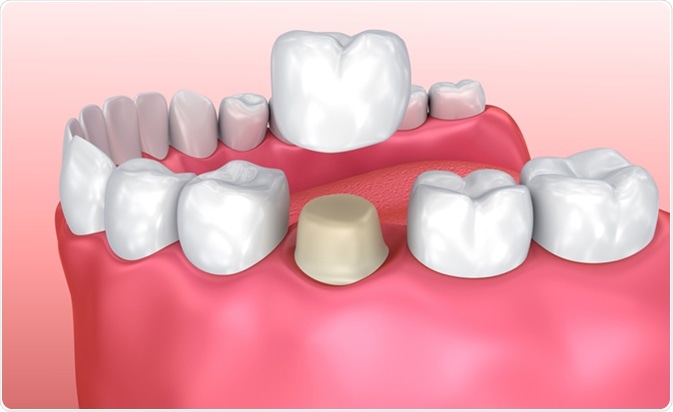There are various reasons for which a dental crown may be recommended, including to protect, restore or stabilize a tooth that has been damaged or worn down in some way. It may also improve the appearance of a patient’s smile by changing the size or color of a tooth, or covering a dental implant to create the look of a replacement tooth.

Dental crown installation process. Image Credit: Alex Mit / Shutterstock
Restoration and Protection
A dental crown can restore the appearance and function of a tooth that has broken or been worn down significantly or damaged by decay.
For example, it can be used to restore a tooth after endodontic treatment, or root canal therapy. This procedure involves cutting off the nerve and blood supply to the tooth so that it is devitalized, and the space that previously held the nerves and blood vessels is filled to prevent infection with bacteria. This therapy leaves the tooth considerably weaker and more brittle than vital teeth to that it is prone to fracture. Therefore, a dental crown placed over the tooth can help to protect the weaker tooth from breaking.
A dental crown can also be used to hold the parts of a cracked tooth together so that it does not break completely, thus protecting it from further damage.
Patient Consent Video: Crown Placement
Stabilization
A dental crown can help to support and stabilize other dental prosthetics, such as a dental bridge or denture. A common example of this is when a crown is fixed to two healthy teeth, one on either side of a gap where a tooth is missing. This provides two anchor points where the bridge can be fixed and held firmly in place. However, this technique is becoming less common since the introduction of dental implants, which does not require dental work on the adjacent healthy teeth.
Appearance
The appearance of the teeth is important for many people because it is a big factor in the look of an individual’s smile and face, and it contributes to their overall confidence. A crown can provide a cap to cover severely discolored or otherwise damaged teeth when partial coverage with a veneer or laminate is not an appropriate choice.
A dental crown can be used to cover and support a tooth that has a large filling when only a small part of the original tooth remains. This is useful because a veneer cannot usually be placed with long-term durability when only a small part of the tooth remains. In contrast, a crown is able to provide full coverage to alter the size, shape and color of the tooth.
Another example when a dental crown can be used to improve the appearance of a patient’s smile is when a crown covers a tooth or filling that has been discolored, to give it a more natural look. A dental crown can be used to cover a dental implant and replace a tooth, improving the appearance of the mouth.
Uses of Dental Crowns in Children
Dental crowns are also occasionally used on primary teeth, also known as baby teeth, which will be temporary because these teeth eventually fall out as the child grows. Possible indications for dental crowns on primary teeth include to:
- Save a decayed tooth that is too damaged to support a filling
- Protect a tooth that is at high risk of decay
- Reduce the frequency of general anesthesia required
Given that dental crowns used on primary teeth have a limited lifespan until the tooth naturally falls out, a stainless steel crown is most commonly recommended.
References
Further Reading